How Advanced Manufacturing Techniques Are Redefining the Eyewear Industry
1. The Evolution of Eyewear Manufacturing: From Craftsmanship to Precision
1.1 Historical Context: The Artisanal Roots of Eyewear
For centuries, eyewear production was a labor-intensive craft. Skilled artisans hand-carved frames from materials like horn, wood, or early celluloid. Each pair was unique but lacked consistency, and production scales were limited. The Industrial Revolution introduced basic machinery, but it wasn’t until the 20th century that glasses factories began adopting semi-automated processes.
The 1980s marked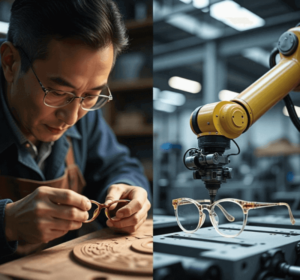 a turning point with the rise of polymer science. Acetate, a plant-based plastic, became the material of choice for its durability and versatility. However, traditional CNC machining and manual assembly still dominated sunglasses manufacture, resulting in high costs and material waste.
a turning point with the rise of polymer science. Acetate, a plant-based plastic, became the material of choice for its durability and versatility. However, traditional CNC machining and manual assembly still dominated sunglasses manufacture, resulting in high costs and material waste.
1.2 The Precision Molding Revolution
Precision molding emerged in the 2000s as a game-changer. By injecting molten materials into computer-designed molds, manufacturers achieved unprecedented accuracy and repeatability. Today, a modern glasses factory leverages this technology to produce frames with tolerances as tight as ±0.02mm, ensuring perfect alignment of hinges, lenses, and temples.
According to a 2023 report by Grand View Research, the global eyewear market, valued at $167 billion, relies heavily on precision techniques to meet consumer demands for lightweight, hypoallergenic, and customizable designs. The shift has also democratized access to high-quality eyewear: precision molding reduces production costs by 20–30%, enabling brands to offer premium products at competitive prices.
2. Sunglasses Manufacture: Where Aesthetics Meet Functionality
2.1 The Dual Challenge: Form and Function
A high-end pair of sunglasses must balance aesthetics with performance. For example, wraparound designs popularized by sports brands like Oakley require seamless curvature to eliminate glare from all angles. Precision molding enables the creation of complex geometries, such as integrated hinge systems and gradient lens tints, which are nearly impossible 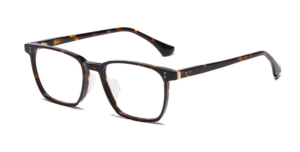 with traditional methods.
with traditional methods.
Luxottica, the world’s largest eyewear conglomerate, revealed in its 2022 sustainability report that precision-molded frames reduce material waste by up to 40% compared to CNC machining. This efficiency is critical as eco-conscious consumers prioritize brands that minimize environmental impact.
2.2 Case Study: Ray-Ban’s Aviator Series
Ray-Ban’s iconic Aviator sunglasses exemplify the marriage of precision and heritage. Originally designed for pilots in the 1930s, the Aviator’s teardrop-shaped lenses and thin metal frames were historically hand-assembled. Today, precision molding allows Luxottica (Ray-Ban’s parent company) to produce these frames at scale with reinforced nylon blends, enhancing durability while retaining the classic silhouette.
3. The Science Behind Precision Molding: Key Innovations
3.1 High-Resolution Molds: The Blueprint of Perfection
Molds are the cornerstone of precision molding. Using laser etching and 5-axis CNC machining, manufacturers create molds with microscopic details. For example, Safilo’s proprietary “NanoMold” technology achieves surface finishes smoother than 0.1µm, eliminating the need for post-production polishing.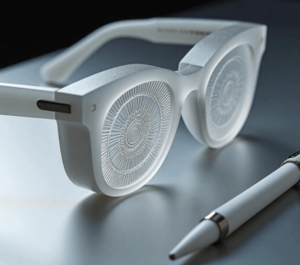
3.2 Multi-Material Injection: Blending Rigidity and Flexibility
Modern frames often combine rigid frontals with flexible temples. Multi-material injection molding allows a glasses factory to inject different polymers (e.g., polycarbonate for the frame and thermoplastic polyurethane for hinges) into a single mold. This reduces assembly steps and enhances structural integrity.
A 2022 MIT study found that multi-material frames exhibit 50% higher fatigue resistance than glued or screwed counterparts, making them ideal for active lifestyles.
3.3 Smart Cooling Systems: Preventing Warping and Defects
Acetate, a popular material for luxury frames, is prone to warping if cooled unevenly. Advanced factories now use AI-driven cooling systems that adjust temperature gradients in real time. For instance, Italian manufacturer Marcolin’s “CoolFlow” technology reduces warping defects by 90%, ensuring flawless acetate frames.
4. Customization at Scale: Meeting the Demand for Personalization
4.1 Digital Scanning and AI-Driven Design
Brands like Warby Parker and Zenni Optical use 3D facial scanning apps to capture over 200 facial metrics, from pupillary distance to nose bridge width. This data feeds into AI algorithms that generate custom frame designs optimized for comfort and aesthetics.
In a glasses factory, adaptive molds adjust parameters like curvature and thickness in real time. For example, German company Rodenstock’s “Individual 2” system produces bespoke frames in batches as small as 50 units, a feat unthinkable with traditional tooling.
4.2 The Economics of Bespoke Eyewear
A McKinsey survey found that 70% of consumers are willing to pay a 15–20% premium for personalized eyewear. Precision molding bridges the gap between bespoke craftsmanship and industrial scalability. By automating design adjustments, factories can offer customization without inflating costs.
Japanese brand JINS, for instance, delivers made-to-order glasses in 7 days—a turnaround made possible by modular molds and just-in-time manufacturing.
5. Sustainability: Precision Molding as a Green Solution
5.1 Bio-Based Materials: Reducing Reliance on Fossil Fuels
Companies like Safilo and Eco Eyewear are pioneering molds compatible with bio-based polymers. For example, castor bean-derived acetate reduces carbon emissions by 30% compared to petroleum-based alternatives. Italian startup Xpreen even uses algae-based resins for its ocean-friendly sunglasses.
5.2 Closed-Loop Systems: Toward Zero Waste
In a closed-loop glasses factory, excess resin from molding cycles is recycled back into production. French company Lafont reuses 98% of its acrylic waste, while Austrian brand Silhouette’s “Eco Titanium” line incorporates recycled aerospace metals.
5.3 Energy Efficiency: Cutting Carbon Footprints
Electric injection molding machines, such as those from Haitian International, consume 60% less power than hydraulic models. The European Commission’s 2021 guidelines highlight this shift as critical for achieving carbon neutrality in manufacturing.
6. The Future of Eyewear: Beyond Frames and Lenses
6.1 Smart Glasses: Embedding Tech Seamlessly
Google’s Project Iris and Meta’s Ray-Ban Stories rely on ultra-precise molds to embed micro-displays, sensors, and batteries into sleek frames. These devices require tolerances under 0.05mm to ensure seamless functionality—a benchmark only achievable through precision molding.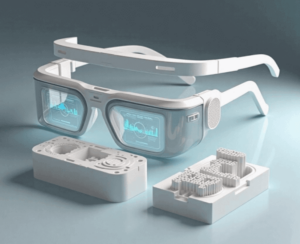
6.2 3D-Printed Molds: Accelerating Prototyping
Additive manufacturing is revolutionizing mold production. 3D-printed molds, like those from Carbon3D, enable rapid prototyping of experimental designs. Deloitte estimates that this technology could cut R&D timelines by 50%, allowing brands to test trends like “gamer glasses” with blue-light filters or adjustable-focus lenses.
6.3 The Rise of Hybrid Materials
Future frames may combine polymers with embedded nanomaterials. For instance, graphene-infused acetate could create self-cleaning, anti-static glasses. Research from the University of Cambridge suggests such materials could enter the market by 2030.
7. Global Market Dynamics: Regional Innovations and Challenges
7.1 Asia-Pacific: The Manufacturing Powerhouse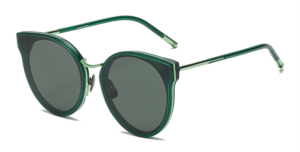
China’s glasses factories in Shenzhen and Xiamen produce 60% of the world’s eyewear, leveraging low labor costs and scalable precision molding infrastructure. However, rising wages and tariffs are pushing brands to diversify production to Vietnam and India.
7.2 Europe: The Epicenter of Luxury Craftsmanship
Italian and French manufacturers dominate the luxury segment. Brands like Chanel and Gucci rely on precision molding to maintain the hand-finished look of acetate frames while ensuring consistency. The “Made in Italy” label alone commands a 40–50% price premium, per Bain & Company.
7.3 North America: Tech-Driven Disruption
U.S. startups like Pair Eyewear (magnetic interchangeable frames) and Hubble Contacts (direct-to-consumer models) use precision molding to disrupt traditional retail. The North American market is projected to grow at a 5.8% CAGR through 2030, fueled by tech integration.
8. Quality Control: Ensuring Excellence in Every Pair
8.1 Automated Inspection Systems
Advanced factories employ machine vision systems to scan every frame for defects. EssilorLuxottica’s “QualiEye” technology detects flaws as small as 0.01mm, rejecting subpar units before they reach consumers.
8.2 Stress Testing for Durability
Frames undergo simulated wear-and-tear tests, including:
- Hinge Flex Tests: 10,000 open/close cycles.
- UV Exposure Tests: 500 hours under artificial sunlight.
- Chemical Resistance Tests: Exposure to sweat, oils, and cosmetics.
Only frames passing these rigorous checks earn certifications like ISO 12870, the global standard for eyewear safety.
9. Consumer Education: Bridging the Knowledge Gap
9.1 Transparency in Production
Companies like Pala Eyewear publish detailed “craftsmanship stories” explaining how precision molding reduces waste. Such transparency builds trust and justifies premium pricing.
9.2 The Role of Retailers
Opticians and online platforms play a crucial role in guiding consumers. For example, LensCrafters’ “Virtual Try-On” tool uses AR to show how different frame materials (e.g., titanium vs. TR-90) suit individual faces.
10. Conclusion: Precision as the New Standard
In an industry where aesthetics, comfort, and innovation collide, precision molding has emerged as the backbone of modern eyewear manufacture. From luxury sunglasses manufacture to affordable daily-wear glasses, this technology ensures that every pair meets exacting standards of quality and sustainability.
As consumer expectations evolve, glasses factories that embrace precision-driven processes will not only survive but thrive—ushering in an era where eyewear is as much a marvel of engineering as it is a fashion essential.

